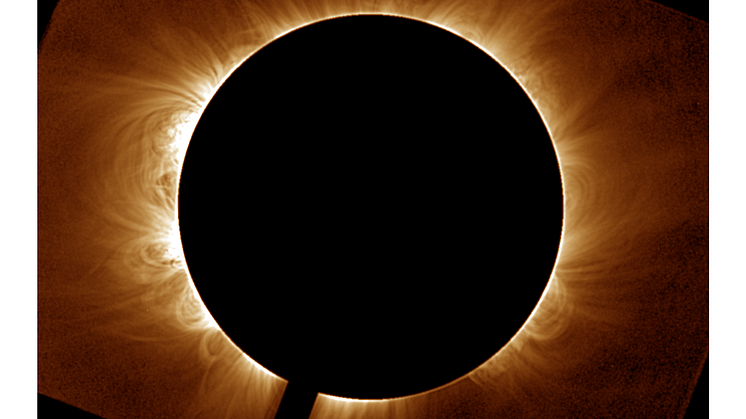
Press release -
First successful routine measurements of Sun’s magnetic field in the corona
A team of scientists have successfully carried out regular measurements of the outermost layer of the Sun’s atmosphere for the first time – giving us a much better understanding of the magnetic field within this region, known as the solar corona.
The Sun’s magnetic field plays a key role in shaping its atmosphere, with activity such as solar eruptions and the heating of the corona to millions of degrees Celsius direct results of the evolution of solar magnetic field over different time scales.
Close to the sun’s surface the magnetic field is strong, making it easier to measure, but in the corona the radiation is much weaker, meaning it has historically been difficult to monitor.
Four years ago, researchers from Peking University, China; the National Center for Atmospheric Research, USA; and Northumbria University in the UK, made a breakthrough when they provided the first global measurements of the corona’s magnetic field through seismology, using observations from the Coronal Multi-channel Polarimeter (CoMP) instrument to determine how fast magnetic waves are moving through the Sun’s corona.
Since then, they have continued their observations and have today published new research in the journal Science detailing the results of eight months of continuous measurements of the magnetic field in the Sun’s atmosphere using data from CoMP, which is based in Hawaii.
Between February and October 2022, the team produced 114 maps of the coronal magnetic field, achieving a measurement frequency of roughly once every two days.
They were able to measure the magnetic field strength at different altitudes within the corona over multiple solar rotations and identify discrepancies in the predicted magnetic field strength within high-latitude and active regions.
Northumbria University’s Dr Richard Morton has been involved in the research over the past four years. His area of work focuses on magnetic waves, also known as Alfvén waves, and their ability to transfer energy through a star’s atmosphere.

Speaking about this latest research he said: “How fast the Alfvén waves move depends on how strong the magnetic field is, so by tracking their movement we can build up a picture of the sun’s magnetic field at different distances from its surface.
“We have been developing software to follow the movement of Alfvén waves and applying this to months’ worth of data from CoMP has given us a much clearer picture of how these waves behave in the corona and the impact they are having on solar activity.”
The coronal magnetic field is the main energy source for coronal heating and space weather effects. It can impact the Earth's space environment through solar wind and coronal mass ejections, posing potential threats to spacecrafts, communication system and other human activities.
By demonstrating the possibility of continuous and long-term measurements, Dr Morton and his research colleagues have opened new avenues for studying and predicting space weather in future.
In 2020 Dr Morton was awarded a prestigious UKRI Future Leader Fellowship for his research into Alfvén waves and over the last four years has led a team of academics from Northumbria, as well as the National Center for Atmospheric Research and Harvard Smithsonian Centre for Astrophysics in the United States, and the Instituto de Astrofísica de Canaria in Spain as part of the Revealing the Pattern of Solar Alfvénic Waves (RiPSAW) project.
His Fellowship has now been extended for a further three years, during which he will analyse data from the National Science Foundation’s Daniel K. Inouye Solar Telescope (DKIST) – a four-meter solar telescope on the island of Maui, Hawaii, and currently the largest solar telescope in the world.
He said: “I was delighted to be awarded time using the DKIST telescope – this is a new instrument and I’m looking forward to seeing how the data we gather can further improve our understanding of the corona by tracking the movement of Alfvén waves.”
Dr Morton joined Northumbria in 2012 as an Anniversary Research Fellow in the University’s Department of Mathematics, Physics and Electrical Engineering. In 2014 he was awarded a Leverhulme Trust Early Career Fellowship.
His contribution to the field of Solar Physics has been recognised with the award of the Royal Astronomical Society's Winton Capital prize in 2015 and Fowler Award in 2021.
Dr Morton is a member of Northumbria University’s world-class Solar & Space Physics peak of research excellence.
The paper, Observing the evolution of the Sun’s global coronal magnetic field over eight months, has been published in the journal Science.
Header image - an image showing the Sun’s disc blocked out by a coronagraph, having a similar effect as the moon during a solar eclipse. The image is taken in infrared light. The bright wispy, hair-like features are where the Sun’s gas is highlighting the magnetic field. Courtesy: HAO/NCAR. Design: R Morton
Topics
Categories
UNIVERSITY OF THE YEAR 2022 (Times Higher Education Awards)
Northumbria is a research-intensive university that unlocks potential for all, changing lives regionally, nationally and internationally.
Two thirds of Northumbria's undergraduate students come from the North East region and go into employment in the region when they graduate, demonstrating Northumbria's significant contribution to social mobility and levelling up in the North East of England.
Find out more about us at www.northumbria.ac.uk
--- Please contact media.communications@northumbria.ac.uk with any media enquiries or interview requests ---







